Like technology speakers will tell you, this year alone, more than 6.4 billion electronic devices will be connected online, many of which can allow you to collect and mine thousands of individual data points that provide details on everything from customer purchasing patterns to how long prospective clients are spending on your organization’s websites. And, 5.5 million new things are getting connected with each passing day.
Needless to say, we’re only going to see more devices from home appliances to even toys getting connected. Even Barbie’s new Dream House accepts voice commands.
As much as big data is the buzzword lately though, as technology speakers should also mention in any informed discussion about new megatrends, it’s SMALL DATA that really matters most. And when I’m talking about SMALL DATA, I don’t mean the trillions of facts you could be combing through, but rather the three to four actionable data points that can help you more effectively solve any problem or capitalize emerging opportunities to knock profits out of the ballpark. Literally thousands of analytics tools now can provide access to nearly any piece of info you could imagine. As consultants to Fortune 500 firms, our clients are typically drowning in information. What they really need to know is: What specific insights can help us take our business to the next level?
But here’s the beauty—as technology speakers can affirm, finding those insights doesn’t have to be like looking for a needle in a haystack. And getting the answers you need shouldn’t have to happen strictly as a reactive measure. Today, we operate in what I call the NEW ERA OF SMART—an age where technology can increasingly help us spot trends and opportunities, even before the market realizes they’re there. And, of course, even help us recognize what it is that our customers want, even before customers themselves know they even want it.
If we as business leaders want the organizations that we work with to succeed more frequently going forward, we’ve also be smarter about empowering them to apply diverse methods of leveraging and capitalizing on this technology. And of course, we also have to be better about allowing them to think more intelligently about how they use this data, so that they can apply more diverse methods of putting these high-tech tools to work.
- Nowhere can you see this principle harder at work than in the video game industry—a field where countless new products are flooding the market, increasing commoditization, and shrinking barriers to entry have all but leveled the competitive landscape.
- Literally 500 new video games are released a day for mobile devices alone—not counting PCs, PlayStations, and Xboxes. Many of these games are completely free to play. All are increasing in quality with each passing year. And with so much choice, very few are capable of capturing and holding customers’ attention or loyalty anymore.
- These games are so successful because SMALL DATA and analytics are the driving force behind several of today’s biggest gaming hits. Many online games and downloadable apps come armed with analytics solutions, for example, that track every action you take, and every button you tap on.
- Game operators are increasingly monitoring buying patterns, tracking which features most resonate, and even personalizing in-game offers to each customer’s playing habits.
- Today, many successful game developers can actually predict which features, pricing programs, and even which new video game titles to introduce next—even before customers know they want these offerings.
- And designers are constantly retooling and updating their software applications to be more lucrative, more enjoyable, and less risky on a daily basis.
Imagine being a senior leader at a popular video game maker like Activision. These guys have spent over 30 years championing the idea of professional game designers building grand-scale works of art from Call of Duty to World of Warcraft? Now suddenly, you’ve got to switch your operating model for huge portions of the business more from products to services—many of which are free to play, and many that you’ll have a computer, not a professional designer, now telling you which features are best to add going forward.
Now try to imagine these leaders asking you to be OK with that kind of radical re-imagining of the business. Increasingly, we as working professionals are going to have to consider these kind of issues—questions about how our organizations are going to have to change and prepare ourselves in coming years to adapt to the rise of high-tech solutions, and this new era of smart. And, of course, we’re also going to have to consider to what extent this kind of technology will no longer be a tool, but also a guiding force going forward. As you can see, diversity of tactical approaches is also going to be a hot topic in the future.
GET YOUR FREE COPY NOW!
books
Limited-Time Offer: Download Free eBook THINK SMARTER Today!
No spam. We respect your privacy.














